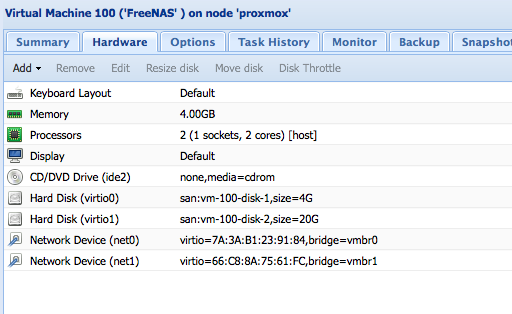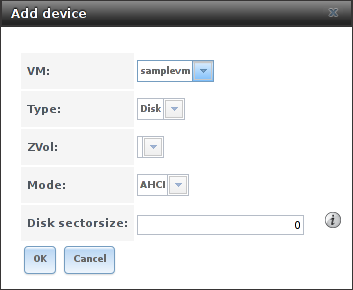

FreeBSD (the underlying OS of FreeNAS) is not the best virtualization guest: it lacks some virtio drivers, it lacks some OS features that make it a better behaved guest, and most importantly, it lacks full support from some virtualization vendors. FreeNAS Setup in Proxmox VE with Pass-through. And for those wondering, yes, you can simply add a Ceph disk to FreeNAS in this configuration and use FreeNAS to store information on your Ceph cluster. Again, this is just for experimentation purposes only and I would highly advise only trying that on a 10Gb network with at least 12 SSDs or 30+ hard drives in the Ceph cluster.
Virtual Machines A Virtual Machine ( VM) is an environment on a host computer that can be used as if it were a separate physical computer. VMs can be used to run multiple operating systems simultaneously on a single computer.
Operating systems running inside a VM see emulated virtual hardware rather than the actual hardware of the host computer. This provides more isolation than, although there is additional overhead. A portion of system RAM is assigned to each VM, and each VM uses a for storage.
While a VM is running, these resources are not available to the host computer or other VMs. FreeNAS ® VMs use the virtual machine software.
This type of virtualization requires an Intel processor with Extended Page Tables (EPT) or an AMD processor with Rapid Virtualization Indexing (RVI) or Nested Page Tables (NPT). To verify that an Intel processor has the required features, use to run grep VT-x /var/run/dmesg.boot. If the EPT and UG features are shown, this processor can be used with bhyve. To verify that an AMD processor has the required features, use to run grep POPCNT /var/run/dmesg.boot. If the output shows the POPCNT feature, this processor can be used with bhyve. 16.1 Virtual Machines The (Options) menu has options for controlling and modifying VMs: • Edit changes VM settings. • Delete removes the VM.
Used in and image files used in devices are not removed when a VM is deleted. These resources can be removed manually in Storage ‣ Pools after it is determined that the data in them has been backed up or is no longer needed.
• Devices is used to add, remove, or edit devices attached to a virtual machine. • Clone copies the VM. The new clone has _clone N appended to the name, where N is the clone number. Start boots a VM. An option is provided to Overcommit Memory.

Memory overcommitment allows multiple VMs to be launched when there is not enough free memory for all of them to run at the same time. This option should be used with caution. When active, the VM State changes to RUNNING. When a VM is RUNNING, more buttons in the (Options) menu are available: • Power off immediately halts the VM.
This is equivalent to unplugging the power cord from a computer. Homemade antenna wifi. • Stop shuts down the VM.
• VMs with Web Interface enabled show a VNC button. VNC connections permit remote graphical access to the VM. • Serial opens a connection to a virtual serial port on the VM. /dev/nmdm1B is assigned to the first VM, /dev/nmdm2B is assigned to the second VM, and so on. These virtual serial ports allow connections to the VM console from the. 16.1.1 Add VM The configuration options are described in.
Table 16.1.1 VM Wizard Options Screen # Setting Value Description 1 Virtual Machine (VM) Wizard type drop-down menu Select a Virtual Machine (VM) or Docker Host. 2 Guest Operating System drop-down menu Choose the VM operating system type. Choices are: Windows, Linux, or FreeBSD. See for detailed instructions about using a different guest OS. 2 Name string Name of the VM. An error is shown if the name is already used by an existing VM.
- Author: admin
- Category: Category
Search
Most Viewed Articles
- Uranium Backup Codigo De Activacion De Eset
- Shillingburg Fundamentals Of Fixed Prosthodontics Pdf Free Download
- Instrukciya Po Ohrane Truda Predsedatelya Tszh
- Dominando El Arte De La Cocina Francesa Pdf
- Buku Olimpiade Matematika Sma Pdf To Jpg
- Install Band Expander Mazda Atenza
- Promo Only Music Video Torrent
- Names Of Tv Serials On Star Plus
- Adobe Illustrator Embroidery Plugin Photoshop
- Mastercam X4 Full Crack Bandicam
- Mtester V207 Proshivka
- Driver Sony Vaio S Series Vpcs113fg 64 Bit
- Prikaz Mz Rb 622 Ot 23052012 Po Tuberkulezu

FreeBSD (the underlying OS of FreeNAS) is not the best virtualization guest: it lacks some virtio drivers, it lacks some OS features that make it a better behaved guest, and most importantly, it lacks full support from some virtualization vendors. FreeNAS Setup in Proxmox VE with Pass-through. And for those wondering, yes, you can simply add a Ceph disk to FreeNAS in this configuration and use FreeNAS to store information on your Ceph cluster. Again, this is just for experimentation purposes only and I would highly advise only trying that on a 10Gb network with at least 12 SSDs or 30+ hard drives in the Ceph cluster.
Virtual Machines A Virtual Machine ( VM) is an environment on a host computer that can be used as if it were a separate physical computer. VMs can be used to run multiple operating systems simultaneously on a single computer.
Operating systems running inside a VM see emulated virtual hardware rather than the actual hardware of the host computer. This provides more isolation than, although there is additional overhead. A portion of system RAM is assigned to each VM, and each VM uses a for storage.
While a VM is running, these resources are not available to the host computer or other VMs. FreeNAS ® VMs use the virtual machine software.
This type of virtualization requires an Intel processor with Extended Page Tables (EPT) or an AMD processor with Rapid Virtualization Indexing (RVI) or Nested Page Tables (NPT). To verify that an Intel processor has the required features, use to run grep VT-x /var/run/dmesg.boot. If the EPT and UG features are shown, this processor can be used with bhyve. To verify that an AMD processor has the required features, use to run grep POPCNT /var/run/dmesg.boot. If the output shows the POPCNT feature, this processor can be used with bhyve. 16.1 Virtual Machines The (Options) menu has options for controlling and modifying VMs: • Edit changes VM settings. • Delete removes the VM.
Used in and image files used in devices are not removed when a VM is deleted. These resources can be removed manually in Storage ‣ Pools after it is determined that the data in them has been backed up or is no longer needed.
• Devices is used to add, remove, or edit devices attached to a virtual machine. • Clone copies the VM. The new clone has _clone N appended to the name, where N is the clone number. Start boots a VM. An option is provided to Overcommit Memory.

Memory overcommitment allows multiple VMs to be launched when there is not enough free memory for all of them to run at the same time. This option should be used with caution. When active, the VM State changes to RUNNING. When a VM is RUNNING, more buttons in the (Options) menu are available: • Power off immediately halts the VM.
This is equivalent to unplugging the power cord from a computer. Homemade antenna wifi. • Stop shuts down the VM.
• VMs with Web Interface enabled show a VNC button. VNC connections permit remote graphical access to the VM. • Serial opens a connection to a virtual serial port on the VM. /dev/nmdm1B is assigned to the first VM, /dev/nmdm2B is assigned to the second VM, and so on. These virtual serial ports allow connections to the VM console from the. 16.1.1 Add VM The configuration options are described in.
Table 16.1.1 VM Wizard Options Screen # Setting Value Description 1 Virtual Machine (VM) Wizard type drop-down menu Select a Virtual Machine (VM) or Docker Host. 2 Guest Operating System drop-down menu Choose the VM operating system type. Choices are: Windows, Linux, or FreeBSD. See for detailed instructions about using a different guest OS. 2 Name string Name of the VM. An error is shown if the name is already used by an existing VM.
Search
Most Viewed Articles
- Uranium Backup Codigo De Activacion De Eset
- Shillingburg Fundamentals Of Fixed Prosthodontics Pdf Free Download
- Instrukciya Po Ohrane Truda Predsedatelya Tszh
- Dominando El Arte De La Cocina Francesa Pdf
- Buku Olimpiade Matematika Sma Pdf To Jpg
- Install Band Expander Mazda Atenza
- Promo Only Music Video Torrent
- Names Of Tv Serials On Star Plus
- Adobe Illustrator Embroidery Plugin Photoshop
- Mastercam X4 Full Crack Bandicam
- Mtester V207 Proshivka
- Driver Sony Vaio S Series Vpcs113fg 64 Bit
- Prikaz Mz Rb 622 Ot 23052012 Po Tuberkulezu